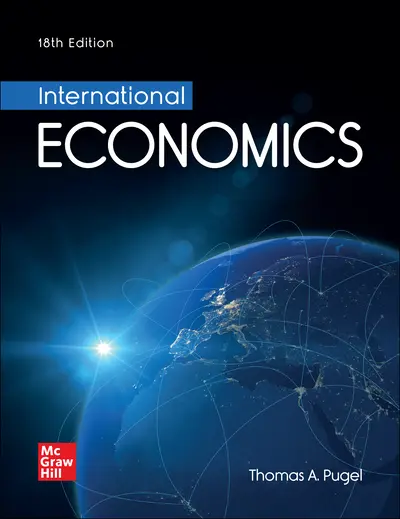My Account Details

ISBN10: 1264436793 | ISBN13: 9781264436798

* The estimated amount of time this product will be on the market is based on a number of factors, including faculty input to instructional design and the prior revision cycle and updates to academic research-which typically results in a revision cycle ranging from every two to four years for this product. Pricing subject to change at any time.
Instructor Information
Quick Actions (Only for Validated Instructor Accounts):
International Economics, 18e combines rigorous economic analysis with attention to the issues of economic policy that are alive and important today in this field. Written in a concise and readable format, Pugel uses economic terminology when enhancing the analysis so that the reader can build their understanding of global economic developments and evaluate proposals for changes in economic policies. The text is informed by current events and includes the latest in applied international research. Like earlier editions, Pugel also places international economics events within a historical framework. The overall treatment continues to be intuitive rather than mathematical and is strongly oriented towards policy.
International Economics is thoroughly integrated with the adaptive digital tools available in McGraw-Hill’s Connect, proven to increase student engagement and success in the course. Connect is the only integrated learning system that empowers students by continuously adapting to deliver precisely what they need, when they need it, and how they need it, so that your class time is more engaging and effective.
Chapter 1: International Economics Is Different
Chapter 2: The Basic Theory Using Demand and Supply
Chapter 3: Why Everybody Trades: Comparative Advantage
Chapter 4: Trade: Factor Availability and Factor Proportions Are Key
Chapter 5: Who Gains and Who Loses from Trade?
Chapter 6: Scale Economies, Imperfect Competition, and Trade
Chapter 7: Growth and Trade
Chapter 8: Analysis of a Tariff
Chapter 9: Nontariff Barriers to Imports
Chapter 10: Arguments for and against Protection
Chapter 11: Pushing Exports
Chapter 12: Trade Blocs and Trade Blocks
Chapter 13: Trade and the Environment
Chapter 14: Trade Policies for Developing Countries
Chapter 15: Multinationals and Migration: International Factor Movements
Chapter 16: Payments among Nations
Chapter 17: The Foreign Exchange Market
Chapter 18: Forward Exchange and International Financial Investment
Chapter 19: What Determines Exchange Rates?
Chapter 20: Government Policies toward the Foreign Exchange Market
Chapter 21: International Lending and Financial Crises
Chapter 22: How Does the Open Macroeconomy Work?
Chapter 23: Internal and External Balance with Fixed Exchange Rates
Chapter 24: Floating Exchange Rates and Internal Balance
Chapter 25: National and Global Choices: Floating Rates and the Alternatives
APPENDIXES
A: International Numbers and Other Information
B: Deriving Production-Possibility Curves
C: Offer Curves
D: The Nationally Optimal Tariff
E: Accounting for International Payments
F: Many Parities at Once
G: Aggregate Demand and Aggregate Supply in the Open Economy
H: Devaluation and the Current Account Balance
Accessibility
Creating accessible products is a priority for McGraw Hill. We make accessibility and adhering to WCAG AA guidelines a part of our day-to-day development efforts and product roadmaps.
For more information, visit our accessibility page, or contact us at accessibility@mheducation.com
Need support? We're here to help - Get real-world support and resources every step of the way.